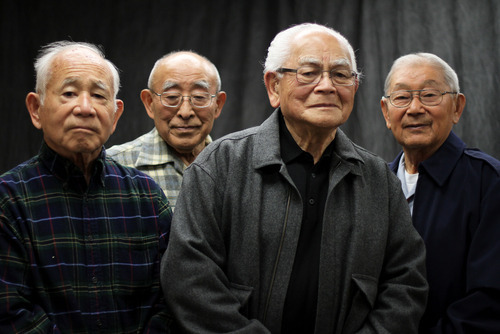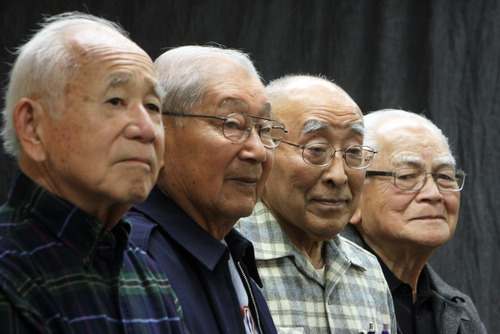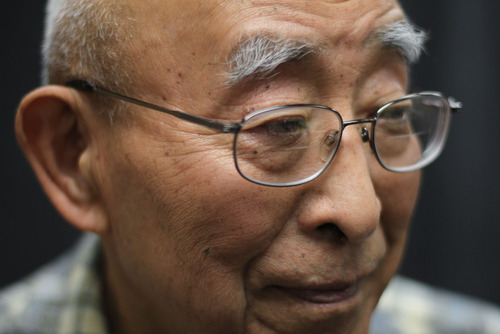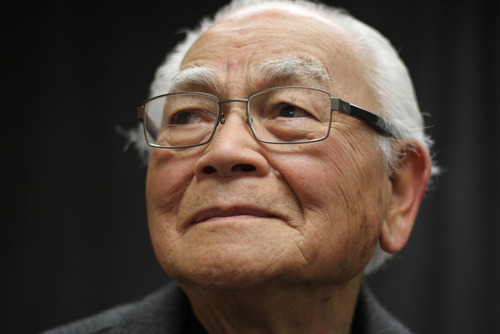This is an archived article that was published on sltrib.com in 2011, and information in the article may be outdated. It is provided only for personal research purposes and may not be reprinted.
The Nisei veterans of World War II, Japanese-Americans who overcame prejudice at home while shedding blood in Europe and contributing mightily as linguists in the Asian Pacific, will receive the nation's highest civilian honor this week in Washington.
But don't ask them to bask in the spotlight.
"It means more to my son and niece than to me," says Taira Fukushima, 85, one of 10 Utah Nisei — second-generation Japanese-Americans — who will leave Monday for the nation's capital. "I did my duty because that's what my dad said you do."
Some 330 veterans of the segregated 100th Infantry Battalion, 442nd Regimental Combat Team and Military Intelligence Service are expected to attend the Congressional Gold Medal ceremony Wednesday at the U.S. Capitol Visitor Center.
In a ceremony the day before, Fukushima will be one of 40 Nisei veterans awarded a Bronze Star Medal, an honor he says bewilders him.
"I didn't contribute that much to World War II," says Fukushima, a retired bacteriologist with the Utah Department of Health. He was imprisoned with his family at Manzanar, one of 10 internment camps Japanese-Americans were forced into as World War II began. He was drafted in 1944 and was a medic — though untrained — with the 442nd in the mountains of Italy and France.
Such modesty is typical of these vets. It's their sons and daughters, grandsons and granddaughters, who want them to be honored, who want their self-sacrifice in an era of injustice to never be forgotten.
Their story "is a wow," says Marion Hori, a member of a committee organizing a celebration of Utah's World War II Nisei vets Feb. 18 in Salt Lake City.
"Here's their country, imprisoning them," Hori says, "and they voluntarily help their country fight the war."
Organizers are trying to identify all Utah veterans who served in the 100th, 442nd and Military Intelligence Service. It's likely there are dozens.
—
Isolated in internment camps • Nelson Akagi, 88, says he and other young Japanese-American men, declared "enemy aliens" by their country, had to prove their loyalty by enlisting in the U.S. Army's segregated units.
After Japan struck Pearl Harbor on Dec. 7, 1941, Hawaii and the West Coast of the United States became military zones, under martial law. The commanding general of the West Coast zone discharged all Japanese-Americans from the Army and sent 120,000 people of Japanese ancestry — half of them American citizens — to inland internment camps, including Topaz near Delta.
Some families, such as Akagi's, were instead allowed to work on farms. His family lost their California home, orange groves and olive business and went to work for U&I Sugar in Parker, near Rexburg, Idaho.
In Hawaii, the military governor did not believe internment was necessary but removed influential Japanese-Americans from the islands. Among those sent to a stateside internment camp was Noel Okamoto's father, a Christian minister on Kauai.
Okamoto's daughter, Vicki Youngblood, of Boise, notes the irony: Her father visited her grandfather in a New Mexico internment camp while the younger man was on leave from Camp Shelby, Miss., where he was training to fight for the United States in Europe.
She and her father, now 89, will travel to Washington on Monday. A teacher who made his career at the now-closed Intermountain Indian School in Brigham City, Okamoto lives in North Ogden.
—
"What we went through" • The segregated 100th Infantry, Nisei soldiers from Hawaii, landed in Italy in September 1943. Their bravery persuaded the Army to send the brigade-size 442nd Regimental Combat Team, also segregated, to Europe. Of the 4,000 men who initially volunteered, 1,500 came from internment camps.
The 442nd reached Italy in the spring of 1944, and the 100th was folded into it. The 442nd lived out its battle cry, "Go for Broke," in Italy, France and Germany.
In 10 months of combat, about 13,000 Japanese-Americans served in the 442nd and more than 700 died. The unit is considered the most decorated for its size and duration of service, with seven Distinguished Unit Citations (later redesignated as the Presidential Unit Citation), more than 4,000 Purple Hearts and hundreds of individual awards.
Hiroshi Aramaki, of Salt Lake City, 86, is one of the unit's decorated soldiers and is headed to Washington.
A native of Price who was in a cannon company and a driver, Aramaki was struck in his side and arm by a mortar shell late in the war. After stints in Florida, Texas and California hospitals, Aramaki "bummed around" a bit, came back to Utah and spent a career as a mechanic and auto-body worker in the Salt Lake Valley, he says.
His daughter, Jeri Aramaki Freedman, will join him as he goes to Washington for the ceremonies.
Akagi, who returned from the war with malaria and "shell shock" — later known as post-traumatic stress disorder — saw one marriage end in divorce. He remarried, and his second wife died four years later, after giving him a son and a daughter. His third wife died several years ago.
Akagi says that as a young soldier he felt bitterness because of the injustices suffered by Japanese-Americans even as they volunteered to serve their country. "I had both patriotism and hate at the same time."
There were "hidden blessings," though. His parents, who settled in the Salt Lake Valley, were able to become citizens because of his military service. Friends helped him get a job.
"Hopefully, what we went through, no other people will go through," says Akagi.
—
"Know the importance of all this" • There has been some healing of the wounds of injustice over the years. The Civil Liberties Act of 1988 led then-President Ronald Reagan to apologize to Japanese-Americans for their treatment during and after the war. Those sent to camps were given $20,000 each in compensation.
Many of the veterans have traveled back to Italy and France and were feted in the villages they helped liberate. Okamoto and his daughter, Youngblood, took two such trips in 2009 and were stunned by the gratitude.
"We would be walking down the street in [Bruyeres] France and there were people who stopped us. They knew who he was, what his unit did," Youngblood says. "They thanked him profusely."
Okamoto reunited with an old friend. Standing in her doorway, he showed her a picture of her family when she was young. "She turned around and on her buffet, she had the same picture we had," says Youngblood. "Now we have pictures of her and him holding their pictures."
Sherrie Hayashi, commissioner of the Utah Labor Commission, and her 14-year-old son, Seiji Hayashi, will accompany her father, Masami Hayashi, to Washington.
A native of Colorado, the 88-year-old Hayashi had studied two years in Tokyo as a teenager, so he was drafted for his language skills into the Military Intelligence Service. He worked as an interpreter and translator during the war-crimes trials in Manila, Philippines, and traveled to Australia as a translator for Army investigators of war crimes.
The retired Bureau of Mines metallurgist, who remains a minister for the Salt Lake Buddhist Temple, says he's honored to go to Washington, but wouldn't do it for himself.
"It's not my father and his generation that are interested in this," says Sherrie Hayashi. "It's me and my son. I want him to know the importance of all this."
His great-grandfather and grandfather fought for the United States in World Wars I and II, but Seiji Hayashi's grandmother's family was imprisoned at Topaz near Delta.
The better he knows that history, says Sherrie Hayashi, the more he'll be able to pass on the lessons about civil rights and service to country.
It's no coincidence, she says, that the Japanese-American community was one of the first to speak out against anti-Muslim bigotry in the wake of the Sept. 11 attacks. "We've already learned that lesson."
Salt Lake County Councilwoman Jani Iwamoto and her family will be in Washington, even though her father, Nobuo Iwamoto, will remain at home in Salt Lake City.
Iwamoto and her husband decided it was a good opportunity to teach their son, 14, and daughter, 12, lessons of history.
"We can tell them all we want … but for them to be there with all the veterans and receive this honor for my dad will be life-changing," Iwamoto says.
—
"A healing thing" • Raymond Uno, a retired 3rd District judge who spent three years in the Heart Mountain internment camp in Wyoming, is heading up the Utah committee organizing the Feb. 18 in Salt Lake City. A Korean War vet himself, he says having Congress award the World War II Nisei with the nation's highest civilian honor does two things.
"It's a culmination of a lot of hurt these people have gone through that they have kept hidden," says Uno. "This really is a healing thing for the whole Japanese community."
Further, he says, the nation might learn of the Japanese-Americans' sacrifice.
"We're saying, 'Thank you for thanking us.' "
Utah's Nisei veterans
These Utah veterans plan to go to Washington, D.C., to join hundreds of other Nisei veterans as the Congressional Gold Medal is awarded to their Army units.
Nelson Akagi
Hiroshi Aramaki
Taira Fukushima
Masami Hayashi
Noel Okamoto
Casey Kunimura
Ray Ogura
Ted Shimizu
Roy Tsuya
Masao Akiyama















